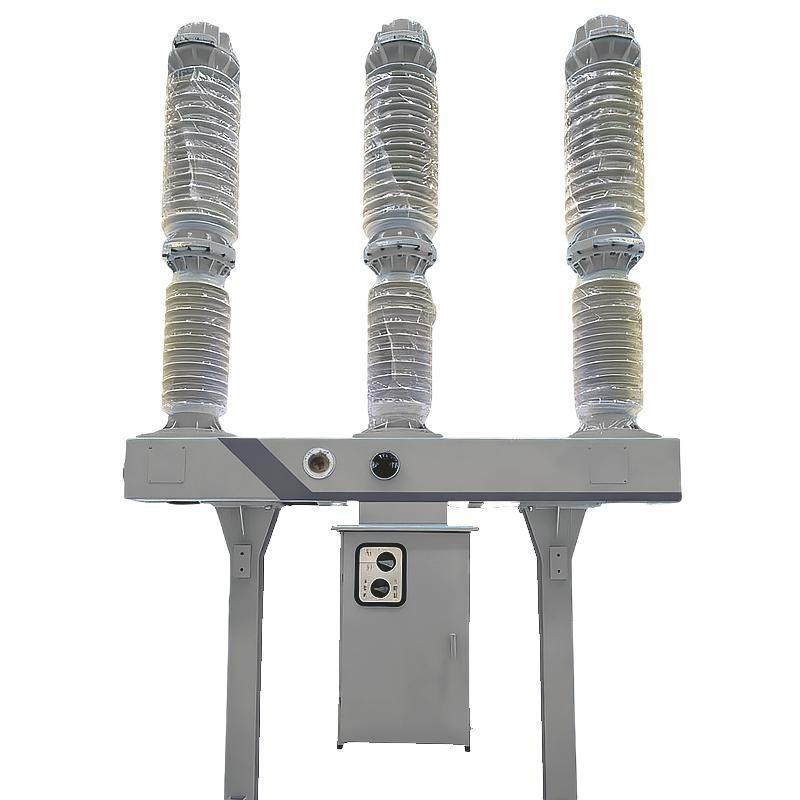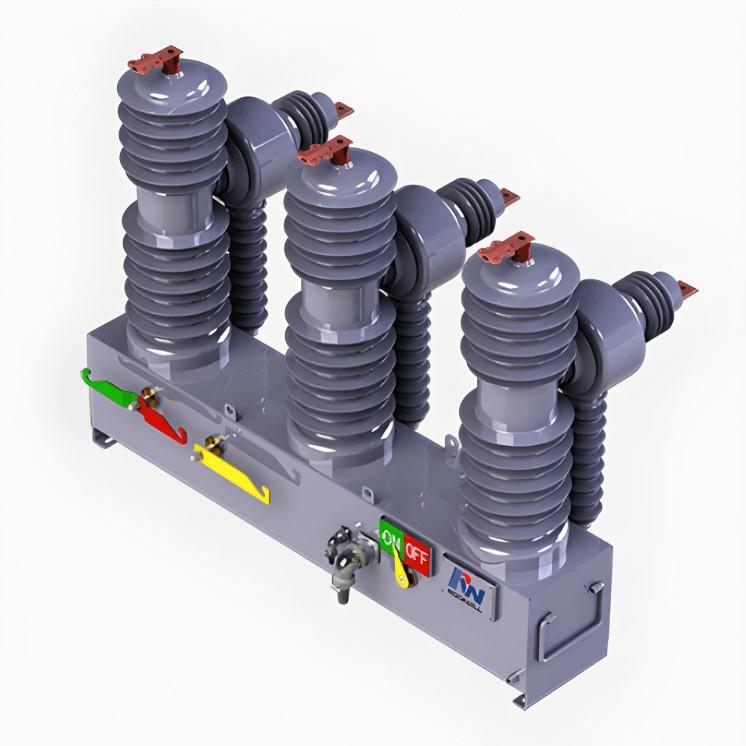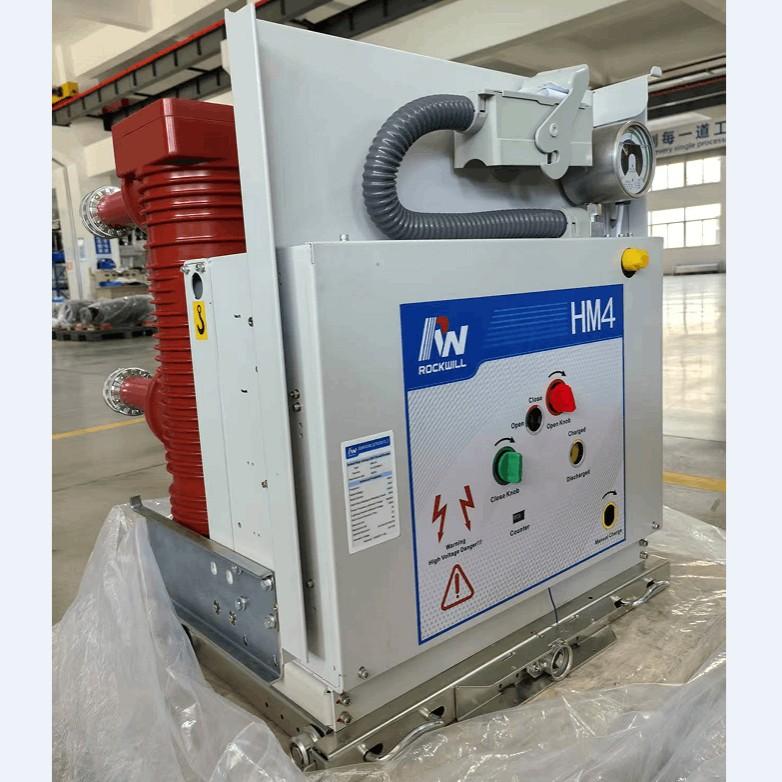1. Análise do Mecanismo de Falha dos Interruptores de Vácuo
1.1 Proceso de Arco Durante a Abertura
Tomando como exemplo a abertura do interruptor, cando a corrente activa o mecanismo de operación para que se dispare, o contacto móvel comeza a separarse do contacto fixo. A medida que aumenta a distancia entre os contactos móvel e fixo, o proceso avanza por tres etapas: separación de contactos, arco eléctrico e recuperación dieléctrica pos-arco. Unha vez que a separación entra na fase de arco, a condición do arco eléctrico xoga un papel decisivo na saúde do interrompedor de vacío.
A medida que aumenta a corrente de arco, o arco de vacío evoluciona desde a rexión do punto catódico e a columna de arco cara á rexión anódica. Con a redución continua da área de contacto, a alta densidade de corrente xera altas temperaturas, causando a evaporación do material metálico do catodo. Ba a influencia do campo eléctrico, forma-se un plasma inicial no intervalo. Aparecen puntos catódicos na superficie do catodo, emitiendo electróns e formando corrente de emissión de campo, erosionando continuamente o material metálico e mantendo vapor metálico e plasma. Nesta etapa, con una corrente de arco relativamente baixa, só está activo o catodo.
Cando a corrente de arco aumenta ainda máis, o plasma inxecta enerxía no ánodo, provocando a transición do modo de arco do ánodo dun arco difuso a un arco restringido. Esta transición está influenciada por factores como o material do electrodo e a magnitude da corrente.
1.2 Análise de Falha por Erosión de Contactos
A erosión de contactos está directamente relacionada coa corrente de interrupción. A potencia nominal de frecuencia, o grao de fusión de contactos é case insignificante. A erosión de contactos ocorre en condicións de alta corrente e alta temperatura. Cando o interruptor interrumpe correntes de cortocircuito que superan a corrente nominal, o grao de erosión de material aumenta bruscamente, creando condicións para a perda de material.
A rugosidade da superficie dos contactos intensifica a concentración de corrente nas saliencias da superficie, levando a un calentamento localizado máis severo. Ademais, a duración da corrente de arco é crítica. Aínda que a corrente sexa de cortocircuito, se a súa duración é demasiado curta, a cantidade de erosión de material permanece pequena.
A causa raíz da falla de contacto é a perda de masa durante o proceso de arco. O dano nos contactos ocorre en dúas etapas:
Erosión de Material: A erosión do material do ánodo está alimentada polo plasma. A densidade de fluxo de enerxía na superficie do ánodo é un parámetro clave para medir o efecto do plasma no ánodo. As investigacións mostran que a densidade de fluxo de enerxía do ánodo aumenta con maior corrente de arco, maior distancia de contacto e menor radio de contacto, promovendo a formación de puntos anódicos e a erosión de material.
Perda de Material: Despois da extinción do arco, as gotas de metal fundido son expulsadas da superficie de contacto debido á presión do plasma. Este proceso está principalmente influenciado polas propiedades do material, con efecto mínimo adicional do arco.
2. Causas de Accidentes de Quema de Interruptores de Vácuo
(1) Desgaste Eléctrico e Variación da Distancia de Contacto que Conduz a un Aumento da Resistencia de Contacto
Os interruptores de vácuo están selados dentro dun interrompedor de vácuo, con contactos móveis e fixos en contacto directo cara a cara. Durante a interrupción, ocorre a erosión de contactos, causando desgaste de contactos, reducindo o espesor do contacto e variando a distancia de contacto. A medida que o desgaste progride, a superficie de contacto deteriorase, aumentando a resistencia de contacto entre os contactos móvel e fixo. O desgaste tamén altera a distancia de contacto, reducindo a presión da molla entre os contactos, aumentando aínda máis a resistencia de contacto.
(2) Operación Fora de Fase que Conduce a un Aumento da Resistencia na Fase Defectuosa
Se o rendemento mecánico do interruptor de vácuo é pobre, as operacións repetidas poden resultar en operación fora de fase debido a problemas mecánicos. Isto prolonga os tempos de apertura e pechado, impedindo a extinción eficaz do arco. O arco pode levar á soldadura (fusión) dos contactos, aumentando significativamente a resistencia de contacto entre os contactos móvel e fixo.
(3) Redución da Integridade do Vácuo que Conduce á Oxidación de Contactos e ao Aumento da Resistencia
Os acordeones nun interrompedor de vácuo están feitos de aço inoxidable fino e actúan como elemento de selado, mantendo a integridade do vácuo mentres permiten o movemento da barra conductora. A vida útil mecánica dos acordeones está determinada polas forzas de expansión e contracción durante a operación do interruptor. O calor transferido da barra conductora aos acordeones aumenta a súa temperatura, afectando a resistencia ao cansancio.
Se o material dos acordeones ou o proceso de fabricación é defectuoso, ou se o interruptor experimenta vibración, impacto ou danos durante o transporte, a instalación ou a manutención, poden desenvolverse vazeamentos ou microfendas. Co paso do tempo, isto leva a unha diminución do nivel de vácuo. Un vácuo reducido permite a oxidación dos contactos, formando óxido de cobre de alta resistencia, que aumenta a resistencia de contacto.
Ba a corrente de carga, os contactos sobreaquecen continuamente, aumentando aínda máis a temperatura dos acordeones e podendo causar a fallo dos mesmos. Ademais, cun vácuo reducido, o interruptor perde a súa capacidade de extinción de arco nominal. Ao interromper correntes de carga ou de falso, unha capacidade insuficiente de extinción de arco leva a un arco sostenido, causando finalmente a quema do interruptor.
3. Medidas Preventivas para Accidentes de Quema de Interruptores de Vácuo
3.1 Medidas Técnicas
As causas da redución da integridade do vácuo son complexas. Evite a vibración e o impacto durante o transporte, a instalación e a manutención. No entanto, a calidade da fabricación e a montaxe na etapa de fábrica son factores críticos que afectan a integridade do vácuo.
(1) Melorar o Material e a Calidade de Montaxe dos Acordeones
Os interrompedores de vácuo usan acordeones para o movemento mecánico. Despois de operacións repetidas de apertura e pechado, poden formarse microfendas, comprometendo a integridade do vácuo. Polo tanto, os fabricantes deben mellorar a resistencia do material dos acordeones e a calidade de montaxe para asegurar a fiabilidade do selado.
(2) Medida Regular das Características Mecánicas e da Resistencia de Contacto
Durante as paradas de manutención anuais, inspeccione regularmente o desgaste eléctrico dos contactos e a variación da distancia de contacto. Realice probas de sincronización, sobrecurso e outras características mecánicas. Use o método de caída de tensión DC para medir a resistencia do circuito. Avalie a oxidación e o desgaste dos contactos baseándose nos valores de resistencia e aborde os problemas de forma oportuna.
(3) Probas Regulares de Integridade do Vácuo
Para interruptores de vácuo de tipo encaixable, os operadores adoitan non poder detectar visualmente descargas externas no interrompedor durante as rondas. Na práctica, as probas de resistencia a tensión de frecuencia de rede son comúnmente utilizadas para avaliar periodicamente a integridade do vácuo. Aínda que esta sexa unha proba destructiva, identifica eficazmente defectos de vácuo. Alternativamente, o uso dun probador de vácuo para a medida cualitativa do vácuo é o mellor método para avaliar a integridade do vácuo. Se se detecta unha degradación do vácuo, o interrompedor de vácuo debe ser substituído de inmediato.
(4) Instalar Dispositivos de Monitorización de Vácuo en Línea
Co uso xeralizado da comunicación sem fíos e dos sistemas SCADA nas redes eléctricas, a monitorización de vácuo en liña tornouse factible. Os métodos inclúen a detección de presión, acoplamento capacitivo, conversión electro-óptica, detección ultrasonora e detección de microondas sen contacto.
Detección de Presión: Incruste sensores de presión no interrompedor durante a fabricación. A medida que o vácuo se degrada, a densidade de gas e a presión interna aumentan. O cambio de presión transmite ao sistema de control para a monitorización en tempo real.
Detección de Microondas Sen Contacto: Usa detección pasiva para detectar sinais de microondas, capturando sinais de retroalimentación únicos cando a integridade do vácuo está comprometida, permitindo a monitorización en liña en tempo real.
3.2 Medidas de Xestión
Nas incidentes pasadas, os operadores non identificaron correctamente as falhas do interruptor, levando á quema e á escalada do accidente. Isto destaca a falta de familiaridade cos sistemas SCADA, co equipo no local e coas proceduras de operación, así como a falta de consciencia de resposta a emergencias. Polo tanto, debe fortalecerse a xestión de operacións nas principais subestacións.
Implemente rigorosamente sistemas de inspección para detectar problemas de forma precoz.
Mellore a formación dos operadores en sistemas SCADA, operación e manutención de equipamentos de conmutación e procedimentos de resposta a emergencias.
Realice simulacros regulares de planificación anti-accidente e de resposta a emergencias.
3.3 Melorar as Funcións de Interbloqueo "Cinco Prevenções" en Armarios de Media Tensión
Actualice tecnicamente as funcións de interbloqueo "Cinco Prevenções" dos armarios de media tensión para cumprir totalmente os requisitos normativos. Os equipos de conmutación de alta tensión completos deben ter funcións "Cinco Prevenções" completas con un rendemento fiable.
Instale indicadores de tensión en vivo no lado de saída do armario. Estes indicadores deben ter funcionalidade de auto-prueba e estar interbloqueados co interruptor de terra do lado da liña.
Para instalacións con capacidade de retroalimentación, a porta do compartimento debe estar equipada cunha fechadura obrigatória controlada por un indicador de tensión en vivo.
A través da análise dos accidentes de quema de interruptores de vácuo causados pola redución da integridade do vácuo, que leva á oxidación de contactos, aumento da resistencia de contacto, sobreaquecimento e fallo final, este artigo propón medidas específicas como mellorar o material e a calidade de montaxe dos acordeones e instalar dispositivos de monitorización de vácuo en liña. Estas medidas axudan a prevenir e monitorizar a degradación do vácuo en tempo real, evitando a recurrencia de accidentes semellantes.






















